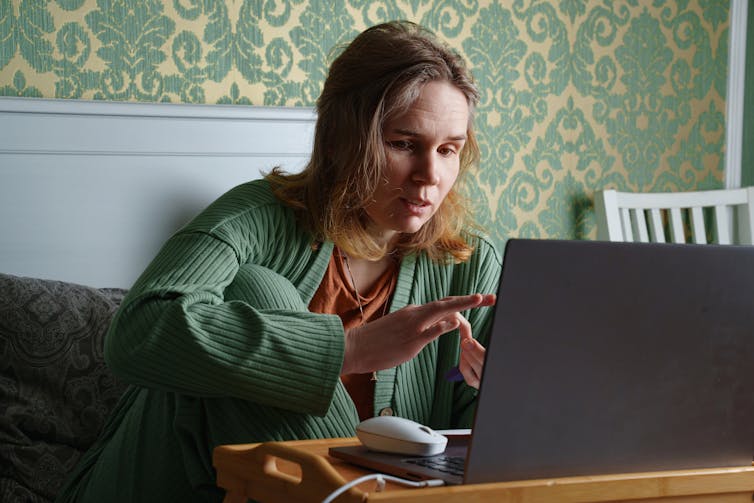
23 Jan Here’s how this new PBS endometriosis drug works and who it might help
Nial Wheate looks at the drug Visanne. It’s for endometriosis and has just been added to the PBS.
The drug Visanne (also known as dienogest) is the first endometriosis treatment to be added to the Pharmaceutical Benefits Scheme (PBS) in 30 years.
Endometriosis is a chronic and often debilitating condition where tissue similar to that which normally lines the uterus grows in areas just outside the organ. It affects around one in seven Australian women, and there is currently no cure.
Why has the government decided to subsidise Visanne? Here’s how this daily tablet works and who it might help.

What is Visanne, and how does it work?
Visanne is a synthetic drug from a family of hormones called progestins. It works by reducing the production of another hormone called estradiol.
Estradiol regulates female reproductive cycles and is the primary female sex hormone. But it also promotes the growth of the endometrium – the tissue that lines the uterus.
Limiting estradiol production in the body helps to lessen the crippling effects of the condition by curbing the abnormal growth of this tissue.
In a 2023 study, Visanne was shown to be effective in controlling the symptoms of endometriosis. After a year of treatment with a once daily 2-milligram dose of the drug, women experienced an average reduction of endometrium growth by around 26%. This led to a significant reduction in the condition’s effects, particularly in alleviating period pain.
In another 2022 study (funded by the company behind the drug), researchers examined its use in nearly 900 women across six countries. They found more than 90% of them reported a drop in endometriosis-associated pelvic pain with drug treatment.
Are there side effects?
Like all drugs, Visanne has risks and potential side effects.
The most common effects include headache, breast discomfort, hot flushes, acne, hair loss, abdominal and back pain, weight gain, vaginal bleeding and unusual weakness.
In the 2022 study, two out of five patients reported side effects related to Visanne, including vaginal hemorrhage (10.4%), bleeding between periods (metrorrhagia – 7.3%) and skipped periods (amenorrhea – 6.4%).
The intensity of side effects often lessen over time. But it can mean those who decide to take Visanne may be balancing pain relief with a range of other new symptoms.
While some endometriosis treatments are associated with a loss of bone density and an increased risk of osteoporosis later in life, the manufacturer claims the drug has little or little impact on bone mineral density.
How much will it cost?
Previously, Visanne’s annual cost to patients was A$800. On PBS, the price of the daily tablets will reduce to around $380 per year or around $90 for pension and concession card holders.
But the Australian government will more than make up the extra expense through the benefits of increasing accessibility of the drug.
Why has it been added to the PBS?
The primary consideration for listing a drug on the PBS is its cost-effectiveness. This means the drug must provide a significant health benefit when compared with the cost of existing treatments.

MashaSay/Shutterstock
Endometriosis has been calculated to cost the Australian economy at least $7.8 billion per year.
Half of women who have endometriosis are reported to have to manage their condition at work, with many having to reduce their working hours. A 2021 study by academics at Western Sydney University found one in six women with endometriosis have lost their jobs due to their endometriosis.
Solutions for helping women to remain and be effective in the workforce are essential to Australia closing the gender pay gap.
However, the cost of Visanne remains high for many individuals, who will still be paying close to $400 a year to reduce their pain and maintain a high quality of life. And many women may need to continue to take other drugs (such as paracetamol) alongside Visanne, further adding to the cost.
Is Visanne right for you?
Visanne is just one available treatment for endometriosis.
There are other effective and safe treatments that are already listed on the PBS, such as combination oral contraceptives, gonadotrophin-releasing hormone drugs and long-acting implants that slowly release progestogens.
It is important to note for some women who take the drug, Visanne can stop ovulation and also make it more difficult to become pregnant.
If you suffer from endometriosis and your current medications are not sufficient to reduce the pain and inflammation, speak to your doctor. They can determine if a change to Visanne is right for you.![]()
Nial Wheate, Professor of Pharmaceutical Chemistry, Macquarie University
This article is republished from The Conversation under a Creative Commons license. Read the original article.


